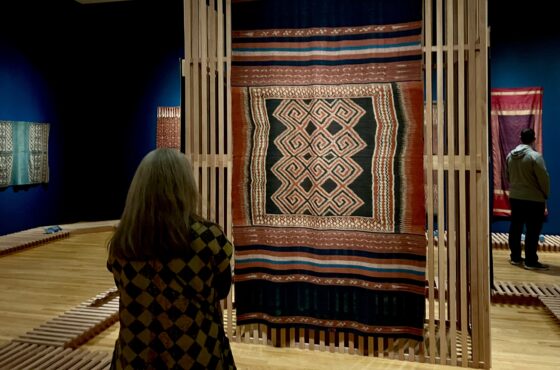This breathtaking exhibition presents more than 100 textiles, including kimonos, furnishings, robes, and other cloths from Africa, Asia, Europe, and the Americas.
My heart skipped a beat when I entered the first gallery, beautifully staged with a breathtaking installation by Rowland and Chiniami Ricketts.
The Ricketts are known for their meticulous process of growing, dyeing, and weaving with indigo. Their installation Zurashi set the tone for the exhibit. Walking among their extraordinary pieces was an immersive experience, like walking through an ikat. Passing through Zurashi, the galleries opened to a global tour of splendid ikat cloths.
This introductory text provides some background, “Of the many cloths in the world, ikat stands out for its required dedication: the weaver must coordinate each and every thread, choosing which to tie to resist the application of dye. Because the process defies exact linear design, some call ikat “blurry,” but others acclaim it as a reminder of the value of the inexact. Ikat gives us an opportunity to appreciate illusion, not illustration.”

I was lucky to be part of the press tour led by Pamela McClusky, curator of the African and Oceanic Art at the museum. She spoke passionately about how this exhibit was a chance to take a break from the world of manufactured products that surround us, how the intimate sense of cloth was exquisitely made, each piece for a very distinct purpose. As we toured the exhibit, McClusky spoke about the regions where ikat has thrived, spanning the last three centuries from Africa, across the Americas, through Asia, and along the Silk Route with a brief stop in Europe. A group of 21st century works by a dozen Indonesian artists were loaned by Threads of Life, an organization that encourages the continuation of ikat.


There were textiles from Japan, including futonji (bed coverings), and kimonos for adults and children. Japanese cloths have a similar palette to those from Africa, with indigo being prevalent. McClusky’s stories led us around the world through the designs and brilliant colors.
As a fiber artist, I experienced each gallery with awe. Every piece was distinct. There were splendidly dramatic robes. There were ikats that were used for ritual observations from India and Southeast Asia. The flowing cloths from Uzbekistan were filled with brilliant colors and spirited designs. The captivating silk velvet robes looked like they came from a textile paradise.
European ikats from 17th and 18th century France captured the moment when the industrial revolution changed the way cloth was made. The American ikats included ponchos from the south and recent works from Santa Fe, New Mexico. Each piece in this exhibit plays a relevant role in the evolution of fabric.
The final piece was a fabric with an interesting ikat pattern—from Pottery Barn! We were encouraged to touch it, and this faux ikat brought us back to the real world.
***
Cami Smith is the Fiber Art Now media manage and contributing editor, and a mixed media artist.
Photos courtesy of Lasse Antonsen.
Subscribe today and get our current issue FREE. Plus, get instant access to 20 original ebooks and 12+ years worth of digital magazines.

Over 120,000 fiber artists connect with Fiber Art Now through our various platforms – and we want you to join us! Connect and get inspired by contemporary fiber arts around the world.
For the latest news, special offers, and exclusive content you won’t find anywhere else, sign up for our newsletter below!